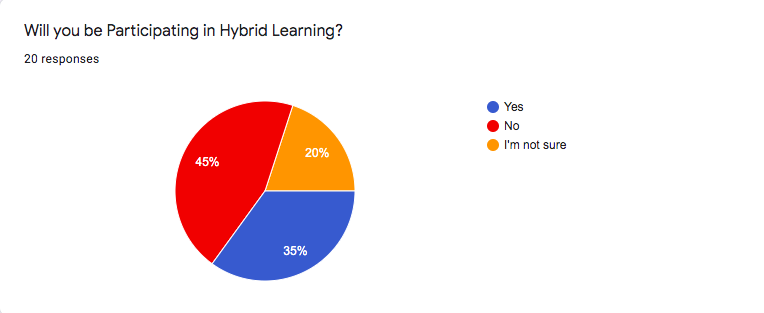Staff Editorial: Hybrid vs Online Learning
HYBRID VS ONLINE LEARNING-The data recorded from Wolfpack Times reporters shows that 20 percent are unsure if they will be participating in hybrid-learning, and 45 percent of reporters will continue school online only. On the other hand, 35 percent of reporters will take part in hybrid-learning if that option is made available. “A lot of students are losing interest in school, not having the same motivation as they did before,” Ashley Padilla, Photography Editor, said.
January 25, 2021
A classroom that was once filled with 30 students and a teacher has become the place that some students now dread the most. Seeing each other every day, smiling, saying good morning, hugging, and interacting with each other has now turned into a computer screen with 30 dark squares labeled with unknown names. The education that students now receive is all at a distance. The question is whether this will end and how hybrid-learning will affect students.
Adapting to distance-learning has not been easy for many students. Staring at a computer screen for five hours isn’t ideal for both younger kids and teens who get distracted easily, especially for those who live in a busy household. Because of the lack of focus, students may be confused with the material that they are working on.
Another negative with distance-learning is that many students are hands-on learners, meaning that they need physical help from a teacher to fully gain an understanding of a topic, which distance learning does not provide.
The problems that distance-learning has brought may be solved with hybrid-learning. This is when students go onto campus twice a week in a cohort with other students to receive in-person learning. However, this new solution comes with its negatives and positives.
The most talked-about problem is student’s mental health. Socialization played a key role in students’ everyday lives which was taken away once students were sent home to quarantine. Hybrid-learning gives students the opportunity to at least interact with some of their peers. “I personally signed-up for hybrid learning because as a senior, I wish to see my classmates and teachers in person before I graduate,” Melissa Ponce, Editor-in-Chief of Design for the WolfpackTimes, said. Those who have been most affected are the seniors, who have no interaction with their graduating class.
Many students have decided that they do not want to participate in hybrid-learning, not only for their health but for the health of their families. “At this moment, I know for sure that I will not be participating in remote-learning because I don’t want to risk my parent’s health,” Daniella Hernandez, Editor-in-Chief of Content for the WolfpackTimes, said. Contracting the virus in a cohort means that students could be spreading the virus within their household.
Students may not only contract the virus on campus but might get it while using public facilities such as a public or school bus to get to school. “Busses get too crowded to go to school, and it becomes an extra risk,” Leslie Chang, a reporter for the WolfpackTimes, said.
Many believe that school isn’t a hotspot for COVID-19 as cases continue rising. “Cases are going up and we’re still online. The school doesn’t play a role in our lives anymore, mental health is only getting worse which is more important than online learning,” Gabriel Dominguez, Sports Editor for the WolfpackTimes, said.
Hybrid-learning is a solution given to students that comes with its own risks and benefits. Whichever students and their families decide, all must stay cautious of their surroundings, wear a mask, social-distance, and try to avoid contracting COVID-19.


